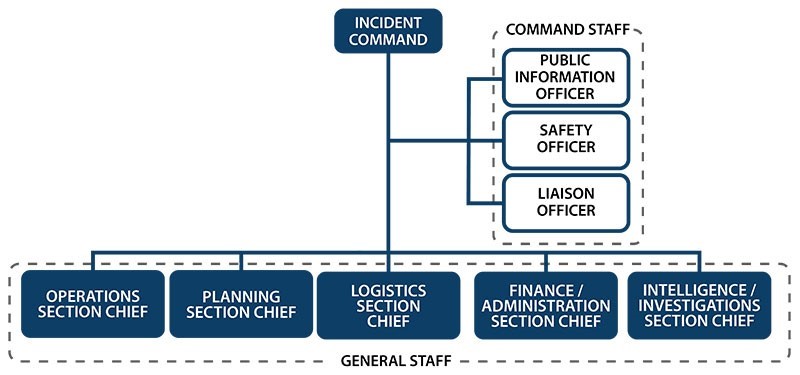By Todd Duncan, Law Enforcement and Safety Specialist
If you have spent any time in a law enforcement leadership role, you know what it is like to be faced with taking charge of a chaotic situation. For example, consider the following scenario: Law enforcement officers from your agency and a neighboring jurisdiction attempt to stop a vehicle with two individuals inside who just committed a serious crime in nearby town, a pursuit ensues, the suspect vehicle crashes, one occupant is seriously injured, and the other escapes on foot. As the supervisor in charge of the incident, you have multiple issues to address including rendering aid to the injured suspect, securing/processing the original crime scene, securing the second scene (vehicle crash/escape), preserving evidence, coordinating the fugitive search, delegating tasks to the deputies/officers on scene, talking to the media who are gathering nearby, briefing the sheriff on what you are dealing with, etc. Having a proven system to manage an incident like this and delegate tasks effectively can bring order to chaos, enhance public safety, and bring the incident to resolution as quickly and smoothly as possible.
For decades, the fire service has relied upon an incident command structure to organize and manage large numbers of responders and resources during major disasters. In the wake of the terrorist attacks on 9/11, then President Bush issued the directive to create a single, national incident management system (NIMS) that would enable responders at all jurisdictional levels and across all disciplines to work together more effectively and efficiently. After evaluating existing command and control systems, the Incident Command System (ICS) became the foundation of the newly created NIMS. The ICS system is intended to be both flexible and scalable, making it useful for managing a variety of situations, whether it is a large pre-planned event or a bank robbery involving a multijurisdictional response.
The Incident Command System thrives on management by objective. Law enforcement is often reactive to major situations until they are resolved. However, ICS allows leaders to manage by objectives and respond proactively by establishing a clear chain of command and written incident action plan (IAP) to achieve those objectives.
The ICS provides a way to bring all involved personnel and resources from one or more agencies into a single operating picture and orderly chain of command. The chain of command may have a single incident commander (IC), or a unified command (UC) team made up of leadership from involved stakeholder agencies depending on the size and scope of the incident. All other elements of the ICS command structure remain the same, regardless of whether the incident is being led by an IC or UC.
The four core functional areas or “sections” of the ICS structure that report to the IC/UC are known as the General Staff and may or may not be filled by a Section Chief depending on the nature of the incident. These functional areas are Operations, Planning, Logistics, and Finance/Administration.
The Command Staff also reports directly to the IC/UC and like the General Staff, may or may not be filled depending on the nature of the incident. The Command Staff is made up of a Public Information Officer (PIO), Safety Officer, and Liaison.

Regardless of whether the IC/UC chooses to fill the positions within the Command and General Staff, the duties of each of these positions must be considered and assigned to someone. For instance, if the IC chooses not to assign someone to the safety officer role, then the IC is responsible for ensuring the safety of operations and involved personnel. You may look at this command model with nine positions when fully staffed and ask, how realistic is this for a two- or three-person agency? The reality is, if you have a major incident or event in your jurisdiction, the odds are personnel from other agencies or counties will be involved and will require coordination. Another benefit of the ICS system is that the roles and sections are based on key tasks or operational areas inherent to nearly every type of major incident, so it helps incident commanders identify critical tasks and delegate them to personnel efficiently.
In summary, ICS is a powerful system that can help you organize chaos. Because it is scalable, it can be used on a relatively small incident like a roll-over crash involving one or more lane closures or a major investigation like a man hunt. It can also be used to manage pre-planned situations like outdoor music festivals or large sporting events.
To learn more about the NIMS/ICS visit FEMA’s NIMS/ICS website and consider completing the following basic NIMS/ICS courses:
- ICS-100, Introduction to Incident Command System
- ICS-200, ICS for Single Resources and Initial Action Incidents
- ICS-700, National Incident Management System: An Introduction
- ICS-800, National Response Plan: An Introduction
Next month we will go into more detail on Incident Action Plans (IAP) which are prepared by the IC/UC with input from the General Staff describing operational goals and objectives as well as how resources will be coordinated and used to respond to a specific incident.
Please contact Todd at 531-510-7446 (cell) or tduncan@nirma.info if you have any questions.

